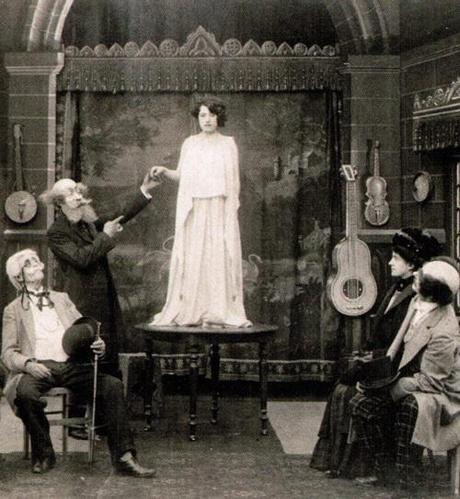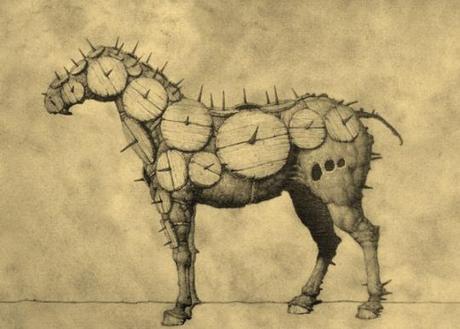
While mockery and pyramiding shapes are dominating symbols in Mourinho’s work, brought to sharper focus by their steady inclusion in the footballing landscapes at Internazionale and Real Madrid, there are two others that are important, both in his personal life and his vision: the race horse and the androgynous playmaker. The mighty horse, quivering in every muscle, nostril open, eyes glaring, hooves frantically stamping, ready for the race or copulation, is of course Cristiano Ronaldo: symbol of sheer animal vitality, bred and nurtured with a single eye to that final outburst of speed which carries defender and rider down the home stretch to victory. From the black heavy-flanked fullback or the low-slung, short-legged chestnut wingback, to the great Maicon and his present-day successors, these horses represented the pinnacle of animal achievement. They were proofs of the game’s skill and intelligence in alliance with the world of life, those hybrids of wheat and sport whose conquest was ultimately more important to the team than were half the mechanical contrivances with which Mourinho’s metropolitan mind struggled.
And if the race horse was animal vitality, the androgynous playmaker was—if one may join the words—animal spirituality, that form of spirit that combines the lonely ascetic endeavors of man and the way a woman fulfills herself in the very organs of the body, in the warmth of the arms, in the tenderness that emanates from the breast, in the receptivity of the first touch controlling the ball, in the utilization of every fiber for the higher ends of the game, making the body not the enemy of the mind, but its friendly guide. Kaká is a creature of this warm intellect. He is not divorced from the earth (the cold intellect of womanless men like Leonardo), but rather in touch with her (the intellect of Goethe). He tends to overvalue his eyes over his muscles: the organs of definition and of physical conquest. The woman in his androgynous jumble teaches him to use the sense of touch, and to diffuse some of the fierce tactile sensitiveness that, in Mourinho’s teams, is at first concentrated so exclusively in the attacking organs. Because of the masculine thoroughbred horse in him, however, the androgynous playmaker also reaches an even deeper vitality, a complete biological fulfillment, never being fully organized or alive except in the relationship between him and the different banks of other players. The through-balls of a Sneijder always have a sardonic gleam in them; they might be the cold exhalations of a depopulated world. Or you could see them as the sterile dream of imperialist conquest, externalized through a glossy, impotent frustration: Rockefeller Center. Kaká’s passes were always an aftermath, auto rolling backward downhill, in the way a lover or a baby plunges into the ultimate womb: the Pierpont Morgan Library or the green slopes at Riverside Park.
_____________________________________________________________________________________________________________________________________________________________________________________________________________________________________________________________________________________________________
1. The race horse: symbol of murky vitality, dimness.
_____________________________________________________________________________________________________________________________________________________________________________________________________________________________________________________________________________________________________

_____________________________________________________________________________________________________________________________________________________________________________________________________________________________________________________________________________________________________
2. The androgynous player: symbol of lukewarmness.
_____________________________________________________________________________________________________________________________________________________________________________________________________________________________________________________________________________________________________

T
he masculine world is a strife of markets, a stultifying ambition to cheapen a match into a duel, to corner the enemy on pugilistic grounds, to invent a substitute for organic life, to conquer a European fixture or a territory of the intellect by an equation or a tactical formula—this masculine world, particularly in our cultural epoch, has tended toward a frustrated asceticism that has left little time and energy for fundamental biological occupations. The androgynous world, whose soil is not too dry and sour, contains a seed that is sound and fruitful, still marked by the great outburst of vitality of the nineteenth century and seen, more often than not, where the earth is not lacking in humus to give the plant itself full growth, in the periphery of our mechanical civilization—in the unbusinesslike Chile of Marcelo Bielsa, in the Brazilians at large, the wastrels and gamblers of Slavic lands, the “low” Hungarians and the Russian “vicious,” among those who preserved an appreciative eye, beyond the hard neck of the horse, for the fetal flanks and belly and buttocks of a soccer woman.
Compare, again, the race horse and the androgynous playmaker. Economically, both are mainly gambling devices; and culturally speaking they are both low forms of activity. Part of their business happens indoors. It is conducted in a clamorous jumble of noises and by a series of telegraphic symbols: the verbal abstractions of the coach sitting on the bench, the automobile factories and packing plantations which pay for their salaries, the mail-order transferring market before the new season unfolds. Another part is held outdoors under the sky: the track, heavy or fast, the accidents of the weather, the suspense of the start, the climax of the home game, a superb aesthetic spectacle, the horseflesh and the human skill.
The drama itself does not terminate abruptly. The tension is prolonged by the evolution of the jockey, or by the return of Kaká as a second-half substitute; the nod that gives him victory is never a question of a judge standing with an upraised hand. Dégas, who according to Lewis Mumford, came closer to anyone else among the painters to represent this drama, shows an impulse to grasp it in terms of continuity, as though anticipating the use of the motion-picture camera. At the bottom of Mourinho’s shamefaced interest in the race horse and the androgynous playmaker, lies an issue of gambling, caught in its artful merry-go-round, and a residual sense of the primitive and the organic in football. The Speedway at 155th Street was maintained and indeed, the track for trotters, famously photographed by Stieglitz, is a common designer of Central Park. Similarly, the Real Madrid supporters whose renewed confidence in Kaká is finally growing out of a murky, grudging admission, are hoping to catch the brute and essential quality of the game; an itch, not an intensity—a furtive, raw piece that would symbolize a passionate soccer mating. ♦

